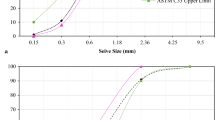Abstract
In order to determine the effect of Natural Pozzolan (NP) content on the mechanical properties and durability characteristics on Engineered Cementitious Composites (ECC) as repair material. This study focused on the evaluation of the most factors influencing compatibility between the repair material and the base concrete including mechanicals properties such as, compressive and flexural strengths, elastic modulus, capillary absorption and drying shrinkage. The experimental results showed that natural pozzolan reduces the compressive strength and the flexural strength of ECC at all ages. The elastic modulus of ECC was remarkably lower than that of normal-strength concrete. This lower Young’s modulus is desirable for repair concrete, because it prevents the stresses induced by restrained shrinkage. In addition, the incorporation of high-volume natural pozzolan decreases significantly the coefficient of capillary absorption at long term and increases the drying shrinkage. Generally, based on the results obtained in the present experimental investigation, ECC can be used effectively as an overlay material over existing parent concrete.
Similar content being viewed by others
References
Matthews S. CONREPNET: Performance-based approach to the remediation of reinforced concrete structures: Achieving durable repaired concrete structures. Journal of Building Appraisal, 2007, 3 (1): 6–20
Zhou J. Performance of engineered cementitious composites for concrete repairs. PhD Thesis, Delft University of Technology, Netherlands, 2011
Mallat A, Alliche A. Mechanical investigation of two fiberreinforced repair mortars and the repaired system. Construction & Building Materials, 2011, 25(4): 1587–1595
Al-Zahrani M, Maslehuddin M, Al-Dulaijan S, Ibrahim M. Mechanical properties and durability characteristics of polymerand cement-based repair materials. Cement and Concrete Composites, 2003, 25(4): 525–537
Emberson N K, Mays G C, Mays G C. Significance of property mismatch in the patch repair of structural concrete. Part 3: Reinforced concrete members in flexure. Magazine of Concrete Research, 1996, 48(174): 45–57
Li M. Multi-scale design for durable repair of concrete structures. PhD Thesis, University of Michigan, USA, 2009
Li V C, Horii H, Kabele P, Kanda T, Lim Y. Repair and retrofit with engineered cementitious composites. Engineering Fracture Mechanics, 2000, 65(2): 317–334
Pattnaik R. Investigation into compatibility between repair material and substrate concrete using experimental and finite element method. PhD Thesis, Clemson University, USA, 2006
Hassan K, Brooks J, Al-Alawi L. Compatibility of repair mortars with concrete in a hot-dry environment. Cement and Concrete Composites, 2001, 23(1): 93–101
Li V C. On engineered cementitious composites (ECC): a review of the material and its applications. Journal of Advanced Concrete Technology, 2003, 1(3): 215–230
Zhu Y, Yang Y, Dang H, Yao Y. Mechanical properties of engineered cementitious composites with high volume fly ash. Journal of Wuhan University of Technology-Materials Science Edition, 2009, S1: 166–170
Yang E H, Yang Y, Li V C. Use of high volumes of fly ash to improve ECC mechanical properties and material greenness. ACI. Journal of Materials, 2007, 104(6): 620–628
Özbay E, Karahan O, Lachemi M, Hossain K, Duran Atiş C. Investigation of Properties of Engineered Cementitious Composites Incorporating High Volumes of Fly Ash and Metakaolin. ACI Materials Journal, 2012, 109(5): 565–571
Zhu Y, Yang Y, Yao Y. Use of slag to improve mechanical properties of engineered cementitious composites (ECCs) with high volumes of fly ash. Construction & Building Materials, 2012, 36: 1076–1081
Lim Y M, Li V C. Durable repair of aged infrastructures using trapping mechanism of engineered cementitious composites. Cement and Concrete Composites, 1997, 19(4): 373–385
Wang S, Li V C. High-early-strength engineered cementitious composites. ACI Materials Journal, 2006, 103(4): 97–105
Li V C. High performance fiber reinforced cementitious composites as durable material for concrete structure repair. International Journal for Restoration, 2004, 10(2): 163–180
Yıldırım G, Sahmaran M, Al-Emam M, Hameed R, Al-Najjar Y, Lachemi M. Effects of Compressive Strength, Autogenous Shrinkage, and Testing Methods on Bond Behavior of High-Early-Strength Engineered Cementitious Composites. ACI Materials Journal, 2015, 112(4): 409–418
Sahmaran M, Yucel H E, Al-Emam M, Yaman I O, Guler M. Bond Characteristics of Engineered Cementitious Composite Overlays. In: Transportation Research Board 92nd Annual Meeting, 2013, 13–1578
Ghrici M, Kenai S, Said-Mansour M. Mechanical properties and durability of mortar and concrete containing natural pozzolana and limestone blended cements. Cement and Concrete Composites, 2007, 29(7): 542–549
EN 12190–6. Products and systems for the protection and repair of concrete structures-Test methods-Determination of compressive strength of repair mortar, 1999
EN 1015–18. Methods of test for mortar for masonry, Part 18: Determination of water absorption coefficient due to capillary action of hardened mortar, 2003
Lepech MD, Li V C, Robertson R E, Keoleian G A. Design of green engineered cementitious composites for improved sustainability. ACI Materials Journal, 2008, 105(6): 567–575
Yang Y, Yao Y, Gao X, Deng H, Yu P, GAO X, Deng H, Yu P. Shrinkage reducing measures for engineering cementitious composites. Wuhan University Of Technology-Materials Science Edition, 2008, 23(6): 907–911
Decter M. Durable concrete repair—Importance of compatibility and low shrinkage. Construction & Building Materials, 1997, 11(5): 267–273
Li M, Li V C. High-Early-Strength Engineered Cementitious Composites for Fast, Durable Concrete Repair-Material Properties. ACI Materials Journal, 2011, 108(1): 3–12
EN 1504–3. Products and systems for the protection and repair of concrete structures-Definitions, requirements, quality control and evaluation of conformity-Part 3: Structural and non-structural repair; 2006
Xinqi M, Zhao T, Zhang P. Optimization of shrinkage and crack resistance performance of Engineered Cementitious Composites (ECC). Electric Technology and Civil Engineering (ICETCE), International Conference on, IEEE, 2011, 6: 534–538
Author information
Authors and Affiliations
Corresponding author
Rights and permissions
About this article
Cite this article
Choucha, S., Benyahia, A., Ghrici, M. et al. Effect of natural pozzolan content on the properties of engineered cementitious composites as repair material. Front. Struct. Civ. Eng. 12, 261–269 (2018). https://doi.org/10.1007/s11709-017-0394-x
Received:
Accepted:
Published:
Issue Date:
DOI: https://doi.org/10.1007/s11709-017-0394-x




